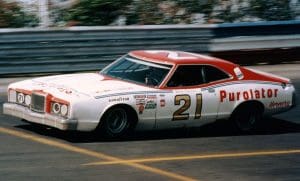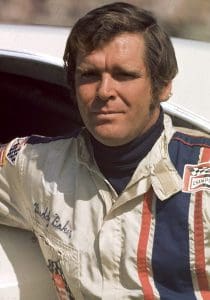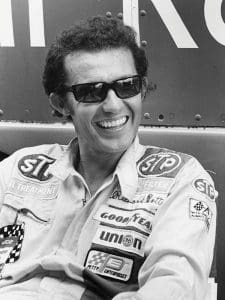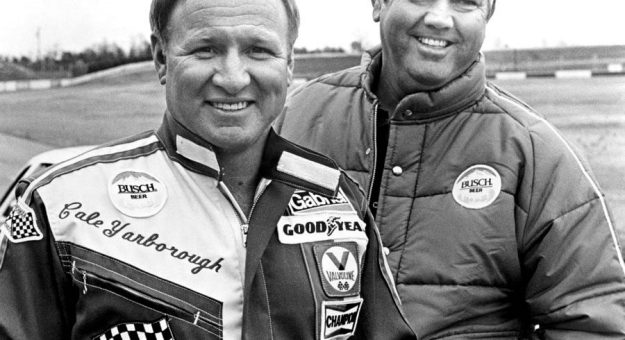To many longtime race fans, the NASCAR drivers who made headlines during the 1970s were part of the sport’s Greatest Generation as their talent and popularity carried stock car racing into its modern era.
Drivers of the 1950s and ’60s built a solid foundation for NASCAR’s Cup Series, but those formative years were difficult as the sport struggled to find its way. By the 1970s, NASCAR’s compass was pointed upward and stock car racing was given new life when R.J. Reynolds Tobacco Co. saw it as an opportunity after cigarette advertising was banned from television.
Broadcast executives began looking at NASCAR racing as a new and exciting form of TV entertainment, even though most races were televised on a delayed basis until CBS’ live coverage of the 1979 Daytona 500 changed the game.
Here are five NASCAR drivers who achieved superstar status during the decade of the 1970s:
Bobby Allison, who grew up in Miami and eventually relocated to Hueytown, Ala., made his first NASCAR Cup Series start in 1961 and became a series regular later in the decade.

Splitting the 1971 season between his own car and one prepared by Ford’s powerhouse Holman Moody operation, Allison went to victory lane 10 times. He then joined forces with driver turned team owner Junior Johnson for the 1972 schedule, and the combination added 10 more wins to Allison’s résumé.
Despite the success, Allison left Johnson’s team at the end of the year with plans to race out of his own shop in 1973. Allison also eventually spent time driving for Roger Penske and he finished the decade with team owner Bud Moore. Allison accumulated 40 of his 84 Cup Series victories during the 1970s.
“The 1970s were good and bad for me,” Allison said. “I had some good years where we won everything in sight and bad years where we couldn’t win if I had the only car in the field, a lot of times because of bad luck in the last 10 laps. But there were some incredibly rewarding times with some great people and great team owners. I especially had some good years driving my own cars and with Bud Moore. I really enjoyed driving for him.”
Buddy Baker, son of 1956 and ’57 NASCAR champion Buck Baker, won his first Cup Series race on Oct. 15, 1967, at his hometown track, Charlotte Motor Speedway.
During the 1970s, Baker won 14 Cup Series races: one for team owner Cotton Owens; one for Petty Enterprises in 1971 and two in 1972; two for team owner Nord Krauskopf in 1973; four for team owner Bud Moore in 1975; another for Moore in 1976; and three for team owner Harry Ranier in 1979.
Baker won two more for Ranier in 1980, including the fastest Daytona 500 when he averaged a record 177.602 mph. His 19th and final victory came for Wood Brothers Racing on July 4, 1983. at Daytona Int’l Speedway. Baker died on Aug. 10, 2015.

“When Buddy started driving for us after Bobby Isaac left Krauskopf’s team, I remember we had to build the cockpits of our Dodges bigger because he was such a big guy at 6-foot-5,” said Buddy Parrott, a crew member for the team. “Buddy only knew two speeds and that was stopped and flat out. He would have won a lot more races had he been able to nurse his engines a little more, but he didn’t know how to do that. He wanted only one view of his windshield and that was from the front.”
David Pearson, a native of Spartanburg, S.C., was known for his ability to win by seemingly coming out of nowhere in the closing laps. He had a quiet demeanor outside the race car and incredible ability inside it. Pearson visited victory lane 105 times during a 26-year career that started in 1960. He passed away on Nov. 12, 2018.
Pearson claimed Cup Series championships in 1966 with team owner Cotton Owens and ’68 and ’69 with Ford’s Holman Moody team. He drove for Wood Brothers Racing from April 16, 1972, through April 8, 1979, winning 43 times. Eleven of those victories came in only 18 starts during the 1973 season.
“(David) Pearson was one of the greatest drivers that we ever had in our cars,” said Eddie Wood, co-owner of Wood Brothers Racing. “That was especially true at Darlington, where he won six of his 10 races there for us. He was the smoothest, coolest and smartest driver that you could imagine.
“People would ask him who would be the best driver in that day’s race and he would say, ‘Who do you think? I’m the best driver.’ And he was right. He would go out and win it. We always went to races knowing we would win when he drove for us and most of the time we did. He didn’t say much. He would just go out and win.”
Mike Hembree, a journalist who has covered NASCAR racing since 1975, was friends with Pearson.
“He was so cool in everything that he did. He was sort of the Steve McQueen of NASCAR,” Hembree said. “I rarely saw him get riled up about anything.
“I talked with him numerous times about his driving style and, of course, you could watch him on the track and it was clear in most races he was babying the car and holding back the last 100 miles. He would say that it wasn’t so much him as it was (former crew chief and engine builder) Leonard Wood making changes to the car. There were only a few pit stops and none during the end of the race, so I think it was mostly Pearson.

“You couldn’t beat him head-to-head in a race where you wanted to outfox him because he was ‘The Silver Fox.’ He was too smart to be outfoxed.”
Richard Petty, a second-generation NASCAR champion from Level Cross, N.C., has long been recognized as stock car racing’s greatest ambassador.
From 1958 through ’92, Petty drove in 1,184 Cup Series races, amassing 200 victories and seven Cup Series championships. During the 1970s, Petty won 89 times and earned five of his Cup Series titles.
Since retiring as a driver, Petty has remained active in the sport as a team owner. He is currently part of the group that owns Legacy Motor Club.
When asked what it means to him to have won more NASCAR Cup Series races than any other driver, Petty responded, “It just happened. I was there the same time they were. They happened to be there the same time I was with their cars.
“I wasn’t there with the Earnhardts and Gordons and Jimmie Johnson,” Petty added. “How would I have fared against them? How would they have fared against me? Those people have won more races than these are going to go to put together. And they’ve done it in a 10- or 15-year period.
“NASCAR started off with Lee Petty and a few guys and they carried on for 10 or 12 years. Then me, Pearson and the Allisons (including Donnie and Davey Allison) and we carried it for a while. Then, Earnhardt came in and he carried it for a while. Jeff Gordon carried for a while. Jimmie Johnson carried it for a while. Now, we’re looking for someone to carry it. We have some good candidates, but none have broken out to get themselves just a little bit better than everyone else. Everything is pretty even now.”
Cale Yarborough, the son of a farmer and country store owner, turned down a football scholarship from Clemson University to pursue a NASCAR career. If there was ever an iron man of stock car racing, Yarborough certainly fits the bill.
Stories of the Timmonsville, S.C., native wrestling an alligator, flying and occasionally crashing airplanes, being struck by lightning twice and competing as a Golden Gloves boxer were all true.
Yarborough won 83 Cup Series races and became the first driver to win three consecutive series championships – 1976, ’77 and ’78. After winning four Daytona 500s and five Southern 500s, Yarborough retired from driving at the end of the 1988 Cup Series season and spent time as a car owner. He passed away Dec. 31, 2023.
In the book “Junior Johnson – Brave in Life,” Johnson said, “I knew Cale was a determined hard charger. With us, Cale took the sport to a higher level … when you have that guy that gives you 100 percent that will hang the car on the wall if he has to every lap in order to win, then you are able to extend. You extend the motors, the chassis set-ups, the gear arrangements, and so forth. You don’t have trouble when you do that. That’s what made the difference with us those three (championship) years.”
More stars emerged during the 1980s who would set their own stories in motion while elevating the NASCAR Cup Series to new heights.
THIS ARTICLE IS REPOSTED FROM THE MARCH, 27th EDITION OF SPEED SPORT INSIDER
SPEED SPORT Insider is the ad-free premium extension of SPEEDSPORT.com. Insider is dedicated to the best and brightest in motorsports journalism – created by the best writers, photographers and reporters in the business. From veteran Hall of Fame writers like Bones Bourcier, Dave Argabright, Pat Sullivan, Keith Waltz, Ralph Sheheen and Editor in Chef Mike Kerchner, to behind the scenes SPEED SPORT reporters like Grace Woelbing, David Hoffman and more.
By subscribing to Insider, you not only get exclusive access to this premium content, but you support the journalists that are vital to telling the stories that matter most. Subscriptions are just $5/mo or $44.95 for an entire year. View plans and details.

